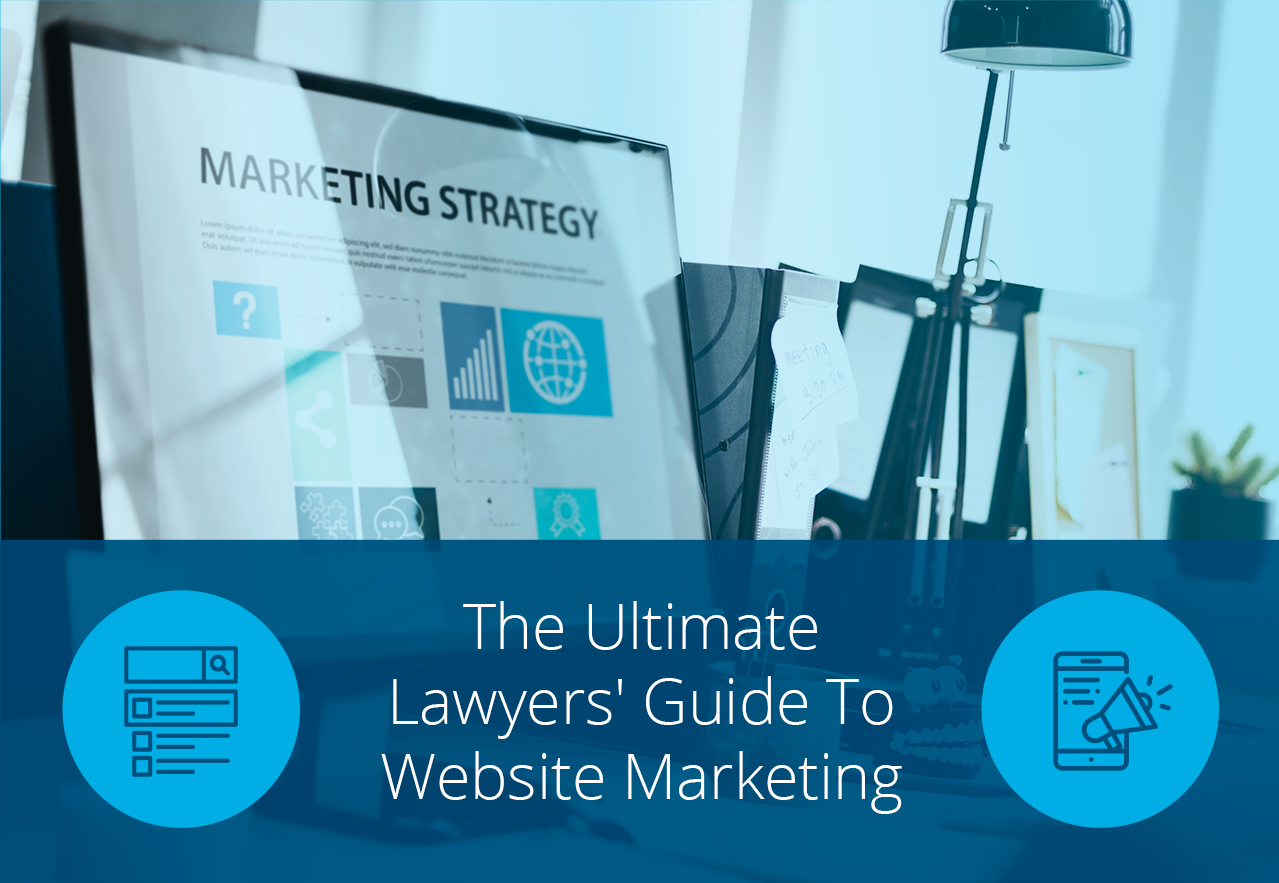Law Firm Marketing 101:
Building The Right Website &
Content
If you run a small or solo law practice, you're probably covering a lot of different job functions in that firm, and finding the right balance between billable work time, marketing and business development, and life can be a challenge under those circumstances. In general, you should consider hiring out any work that can be done by someone whose labor costs considerably less than your hourly bill rate: things like answering phones, billing, and cleaning the office, for example. It's easy to tell yourself that you can do all of those things free, but in a very real way, you're actually paying your own bill rate to do those tasks yourself.
Marketing is one area that tends to get pushed aside among small law firms, because it can be very time-consuming, and because it's a complicated and continually evolving field of knowledge. Every attorney would like to believe that his or her excellent work will speak for itself and they'll earn a living and make a profit with referrals and repeat clients. Unfortunately, for many law firms, this will never happen without a carefully designed marketing plan that begins with good visual branding, and an optimized website with effective and continually updated content.
Visual branding and logo design
Visual branding relies on creating a unique and immediately recognizable set of visuals that, with successful marketing, your customers and prospects will come to associate with your work and reputation. Large corporations spend small fortunes developing complex brand packages, but for a smaller business, a simple plan based on premium quality elements will work fine. A brand package is a set of visual elements to be used in your marketing, along with rules about how those elements will be used. This is important because visual branding relies heavily on consistency. For a small or solo law firm, a branding package might consist of a logo with alternate versions or sizes, a slogan or motto, a set of approved colors and fonts, and guidelines as to what sizes and versions will be used in what circumstances.
Logo design is a topic that deserves a bit of extra attention, because many business owners underestimate its importance, and do not appreciate the very real costs of getting it wrong until it's too late. Logo design finds its roots in medieval heraldry, which used a strict set of principles to ensure that every heraldic device registered would uniquely identify the person or group it represented. Unfortunately, while heraldry is governed by a College of Heralds, there is no college of logos to sort everyone out, so it's up to you to ensure that your logo is unique and significantly differentiated from other logos. This due diligence is one service you can reasonably expect when you work with a professional graphic designer to develop your logo. There are many services online, offering to design logos overnight for extremely low rates, but they do the work that quickly and cheaply by skipping due diligence, and by using stock images and fonts, or a standard set of pre-designed original images they use in all of their clients' designs. These logos fail as marketing devices because they're not unique identifiers. So, now that you've got your visual branding squared away, it's time to work on building a website!
A website is an online brochure, right?
Years ago, business websites were literally a digital brochure: static and non-interactive. In today's marketing world, there are much higher standards, created by modern marketing strategies, by the expectations of buyers, and by the requirements of Google, which currently defines the criteria by which business sites succeed or fail. That may sound like an over-blown statement, but it really isn't. First of all, Google represents nearly 80 percent of the US desktop search market, at present, compared to Microsoft Bing, a distant second, with about 10 percent share of the same market, and Yahoo a distant third place with a little more than 8 percent. The numbers are even more polarized in mobile searches, with Google capturing nearly 95 percent of that market. Google is king and if you want to build a successful marketing website, you'll need to learn and employ some search engine marketing (SEM) and search engine optimization (SEO) strategies in building your website and with your content.
Using sem and seo to your advantage
Google and other search engines use complex algorithms to establish the search engine result page (SERP) ranking of every website for every search term relevant to that site. The criteria those algorithms use to determine SERP rankings are called ranking signals, and although many ranking signals and the weight they carry in the ranking process are never known to the public, Google does announce major ranking signals and changes as they are put into use. Google is a for-profit business, and their success depends on maintaining a reputation for directing users immediately to readily accessible, quality content. They make their profits through advertising, and they keep their ad space filled and rates up with their overwhelming lead in market share. Websites that help Google accomplish their goals are rewarded by boosted SERP rankings, while sites that do not provide Google users with a quality experience are penalized in SERP rankings.
If you take nothing else away from this discussion of SEM and SEO, remember this: among all of the top three search engines, 95 percent or more of users never look beyond page one of their search results. If your website isn't on page one of the SERPs for its most likely search terms, only 5 percent of search engine users will ever see it.
Some of Google's ranking signals involve things you should build into your website from the beginning. Other ranking signals are addressed effectively by producing the right kind of content to begin with, and on a consistent basis as you go forward. When you're at the design phase of your website, you'll give yourself a good start by including Secure Sockets Layer (SSL), mobile responsiveness, and mobile-friendly use of pop-ups in your website. All of these are announced and verified Google ranking signals, and are much easier and less costly to implement from the beginning than they are to retrofit to an existing site. All of these ranking signals, which many business websites still haven't implemented correctly, if at all, offer significant SERP advantages, if you do them right. Working with a professional web developer like Zaliet, which specializes in building websites for law firms, will make it easier and more efficient for you to design a website that includes correct SSL implementation, mobile-friendly interstitials, and the right type of mobile responsiveness for your specific practice and clientele.
Organic SEO and content marketing
Another important set of ranking signals which are commonly misunderstood or overlooked entirely by business websites revolve around the content. Websites are rewarded in SERP rankings by providing a consistent stream of fresh content which is human-readable and useful, original, and optimized with keywords in a way that is not considered "spammy." These ranking signals fall under an algorithm called Google BERT, which encourages well-written content that is only posted on one website (backlinks are not penalized, but publishing content on more than one site is); attempts to root out junk sites that falsely lure people in with misleading keywords; and by penalizing content that is so keyword-stuffed that it's unreadable. Though specific thresholds haven't been revealed, it's current practice among SEO writers to limit keyword density to four percent, although the focus in today's market is more on readable content and less on keywords, so it's more important to write good copy than to pack it with keywords to attract Google's notice. This is another place where hiring outside services may provide a strong return on investment, because writing SEO copy takes a good deal of research time, in addition to continually updated knowledge of ranking signals and other standards, and experience in striking the right balance between compelling writing and marketing copy that "talks at" people.
Build your own marketing tools in
Of course, the whole point of complying with Google's demands and achieving page one SERP placement is to get your brand and message in front of prospects and, ultimately, to convert them to clients. From a content perspective, that conversion process begins with the tone and language your site uses. If your practice is real estate law, and your most likely clients are residential buyers, you need to use everyday language instead of jargon, and realize that in many cases, your prospects are going to be easily overwhelmed, so your content should be presented in "bite-sized" chunks they can take in easily. If you practice corporate law, and your most likely clients are corporate executives, you should use jargon when it helps create expedient communication, because it creates a sense that you are all on the same page and that you understand that time is money.
The base content on your webpages, should create a sales funnel, which walks visitors from a landing page that creates awareness of what you do through a series of additional pages and other content like downloads that lead the visitor through a stage of interest, toward a decision and, ultimately, a "buying" action, like scheduling an appointment to discuss their case with you. Downloads like free e-books or whitepapers can be used as lead magnets, to build your mailing list for marketing materials like newsletters or to promote articles and blog posts you write in the future. Create a successful opt-in form by telling people exactly what they can expect you to send them: "Sign up to receive helpful information about residential mortgages and ways to save money on purchasing your home."
Start out as you mean to go on
Start your law firm's website and marketing plan with an eye to the future, and you'll ultimately save time and money while building toward better brand recognition and success more quickly. To learn more about marketing your small or solo law firm, check out our companion white paper, "Law Firm Marketing 102: Building A Following."
Download The Ultimate Lawyers' Guide To Website Marketing


Download The Ultimate Lawyers' Guide To Website Marketing
Start Your Free 7-Day Trial
No downloads or software to install.
Complete this form for a quick demonstration with a product consultant to begin your free 7-day trial.
Can't see the form below? Click here or please disable your privacy blocker.

